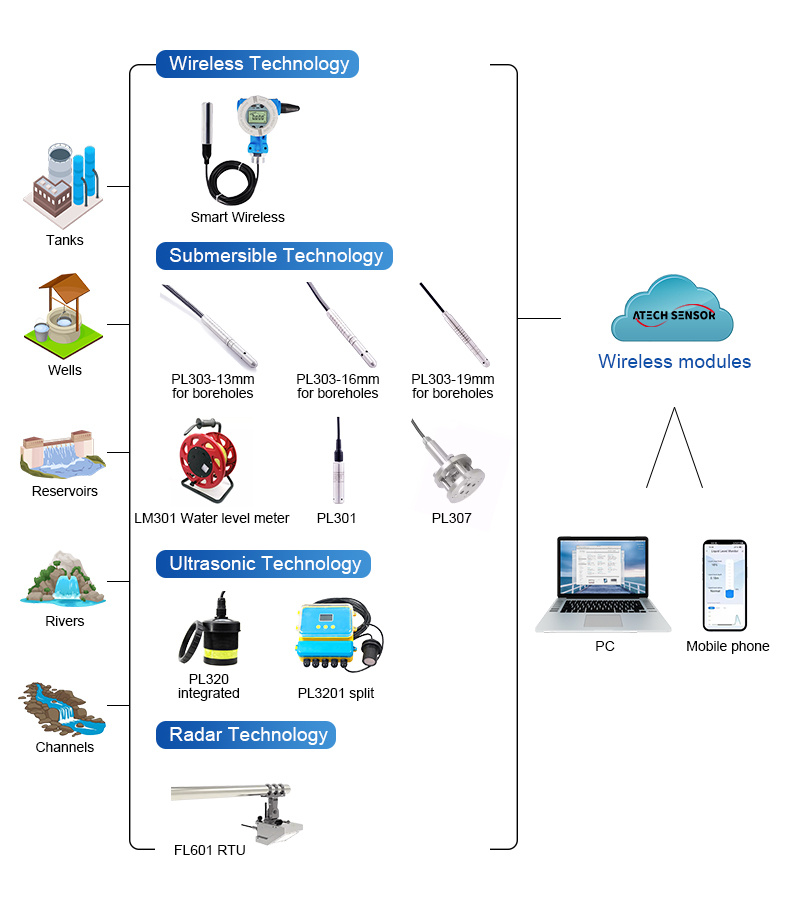In industrial production and scientific research, the liquid level meter plays a crucial role.It can accurately measure the height of liquids and provide key data for the control and safety of production processes.Different types of liquid level meters are suitable for different scenarios, each with unique features and advantages.
1. Glass Tube Level Gauge
Working Principle: The glass tube level gauge works based on the connecting device principle.
It consists of glass tube, upper and lower valves and connecting flanges.The glass tube is connected with the container, when the liquid level in the container changes, the liquid level in the glass tube will also change, so that the height of the liquid level can be directly observed.
Application Scenario: The glass tube level meter is usually used for small containers or occasions that do not require high accuracy, such as laboratories, small storage tanks, and so on.It has the advantages of simple structure, low cost, intuitive and reliable.
Advantages: simple structure, low cost, intuitive and easy to read.Can directly observe the liquid level without external power supply.
Disadvantages: fragile, cannot withstand high pressure, limited measuring range.Not suitable for corrosive, high temperature or high pressure liquids.
2. Float Level Meter
Working principle: Float level meter is mainly composed of float, connecting rod, magnet and transmitter.The float floats up and down with the change of liquid level, and the magnet is driven by the connecting rod to move in the transmitter, so as to change the output signal of the transmitter and realize the measurement of liquid level.
Application Scenario: Widely used in various industrial fields, such as petroleum, chemical industry, electric power, food and so on.Suitable for measuring occasions with large changes in liquid level, such as storage tanks, reaction kettles and so on.
Advantages: wide measuring range, high precision.Simple structure, easy to install.High reliability, not easily affected by external interference.
Disadvantage: The float is easily affected by the viscosity and density of the liquid.For viscous liquids, the float may get stuck.
3. Magnetic Flip-Flop Level Gauge
Working Principle: Magnetic Flip-Flop Level Gauge consists of body, float, magnet and flap, etc. When the liquid level in the container changes, the float floats up and down with the liquid level and the magnet inside the float drives the flap to turn over, thus displaying the height of the liquid level.
Application Scenario: Suitable for various industrial fields, especially for high temperature, high pressure, corrosive liquids with good measuring effect.Such as oil refining, chemical, pharmaceutical and other industries.
Advantages: intuitive display, can be observed from a distance.Large measuring range and high precision.Good sealing, suitable for a variety of harsh environments.
Disadvantages: Higher installation requirements, need to ensure verticality.The price is relatively high.
4. Radar Level Meter
Working Principle: The radar level meter transmits electromagnetic wave, when the electromagnetic wave meets the liquid surface, it will be reflected back, and the height of the liquid level is calculated by measuring the propagation time of the electromagnetic wave.
Application Scenario: Widely used in large storage tanks, reactors and other occasions, especially suitable for high temperature, high pressure, strong corrosive and other harsh environments.
Advantages: high measurement accuracy, not affected by liquid density, viscosity and other factors.Non-contact measurement can be realized, high safety.Applicable to a variety of complex working conditions.
Disadvantages: Higher price, higher requirements for the installation environment.Professionals are required for installation and commissioning.
5. Ultrasonic level meter
Working Principle: Ultrasonic level meter utilizes the propagation speed and reflection principle of ultrasonic waves in the air to measure the height of liquid level.It transmits ultrasonic pulses, and when the pulses meet the liquid surface, they will be reflected back, and the height of the liquid level is calculated by measuring the time difference between transmission and reception.
Application Scenario: It is suitable for the measurement of various liquids, especially for corrosive and viscous liquids with good measuring effect.Such as sewage treatment, chemical, food and other industries.
Advantages: non-contact measurement, easy to install.Not affected by liquid density, viscosity and other factors.Higher precision and relatively low price.
Disadvantages: Highly affected by environmental factors such as temperature and humidity.For occasions where there is interference such as foam and dust, the measurement accuracy will be affected.
6. Capacitance Level Gauge
Working Principle: The capacitance level meter works based on the capacitance principle.It determines the height of the liquid level by measuring the change in capacitance.When the liquid level changes, the dielectric constant of the capacitance will also change, which leads to the change of the capacitance value.
Application Scenario: It is suitable for the measurement of various liquids, especially for corrosive and conductive liquids with good measurement effect.Such as chemical, pharmaceutical, electric power and other industries.
Advantages: high precision and good stability.Can realize continuous measurement, suitable for automatic control system.Not affected by liquid density, viscosity and other factors.
Disadvantages: Higher price and strict installation requirements.Regular calibration is required.
Different types of level meters have their own characteristics and applicable scenarios.When choosing a level meter, you need to consider the measurement accuracy, measurement range, working environment, cost and other factors according to the actual needs.Only by choosing the right level meter can we ensure the safe, stable and efficient operation of the production process.


